Reef Encounter
Author: Richard Breese
Publisher: R&D Games
Year: 2004
review by

| x |
|
|
|
|
|
|
|
|
|
|
|
|
|
|
|
|
|
|
|
|
|
|
|
|
|
|
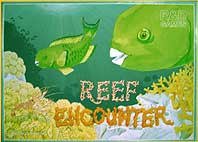 |
|
In this game from Richard Breese we find ourselves at the bottom of the ocean. As we can read in the introduction in the rule book this fascinating world of coral reefs may be beautiful, but not very hospitable. In Reef Encounter, two to four players represent parrotfish that feed on coral. The goal is to grow large corals and feed these to our parrotfish. This is not as simple as it sounds, because the available space is limited and there is violent competition between corals of different colours. Weaker corals can be overgrown by the stronger ones, but luckily the game also provides shrimps that are able to partly protect corals from attacks.
|
| x |
|
|
|
|
|
|
|
|
|
|
|
|
|
|
|
|
|
|
|
|
|
|
|
|
|
|
| The board consists of squares displaying rocks or water. On the rocks, corals can grow. They are composed of polyp tiles that come in five different colours. To start a new coral or to expand an existing coral, the player has to play a larva cube in the colour of the coral he wants to grow. Then, he can place a number of polyp tiles of that colour on the reef board. To claim a coral as his own, a player can place a shrimp of their colour on one of the polyp tiles of the coral. All players start with four shrimps. When a coral consists of at least five tiles, it’s big enough to be eaten by the parrotfish of the owner of the coral. Four tiles of the coral are always returned to the stock; the remainder is placed in the player’s parrotfish-container. The shrimp is devoured as well, and disappears from the game! At the end of the game, the polyp tiles in the parrotfish-container give points, and that is what it’s all about. |
x |
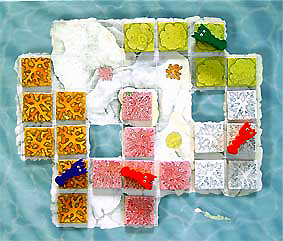 |
| x |
|
|
|
|
|
|
|
|
|
|
|
|
|
|
|
|
|
|
|
|
|
|
|
|
|
|
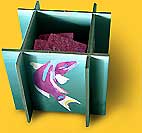 |
Every turn there are ten possible actions to choose from; most of these actions can be performed as often as desired and in any order. Eating a coral with the parrotfish, however, must always be the first action of a turn, and can only be performed once per turn. The last action is always collecting a larva cube of a desired colour and one to three polyp tiles that come with them.
xxxxxxx
|
| x |
|
|
|
|
|
|
|
|
|
|
|
|
|
|
|
|
|
|
|
|
|
|
|
|
|
|
| One of the most important actions in the game is placing polyp tiles. This action can be performed twice per turn. The rules are simple: polyp tiles can be placed on any of the empty rock spaces. Corals of different colours can always be built adjacent; corals of the same colour can only be built adjacent if at least one of them is not guarded by a shrimp. Two guarded corals of the same colour cannot be connected. |
|
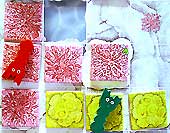 |
| x |
|
|
|
|
|
|
|
|
|
|
|
|
|
|
|
|
|
|
|
|
|
|
|
|
|
|
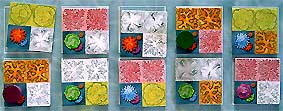 |
|
The most fun element of the game are the coral tiles. These tiles each display two of the five coral colours. One is depicted larger than the other; this large coral is stronger than the smaller coral. On the backside of the tile, the same two colours are shown, but in reversed order: the strong coral on the front is the weak coral on the back vice versa. When placing polyp tiles, spaces that are occupied by a weaker coral can be overgrown by the stronger coral. The attacking coral must be at least two polyp tiles large. |
| x |
|
|
|
|
|
|
|
|
|
|
|
|
|
|
|
|
|
|
|
|
|
Tiles occupied by a shrimp as well as the tiles adjacent to a shrimp are protected from these attacks. The attacker places the consumed polyp tiles in front of his screen.
 x x   x x xx xx
|
|
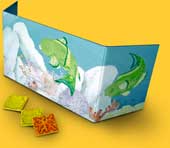 |
| x |
|
|
|
|
|
|
|
|
|
|
|
|
|
|
|
|
|
|
|
|
|
|
|
|
|
|
| x |
|
|
|
|
|
|
|
|
|
|
|
|
|
|
|
|
|
|
|
|
|
|
|
|
|
|
 |
|
|
|
|
|
|
|
|
|
|
|
|
|
|
|
|
|
|
|
|
|
|
 |
|
|
|
|
|
|
|
|
|
|
|
|
|
|
|
|
|
|
|
|
|
|
 |
|
|
|
|
|
|
|
|
|
|
|
|
|
|
|
|
|
|
|
|
|
|
| x |
|
|
|
|
|
|
|
|
|
|
|
|
|
|
|
|
|
|
|
|
|
|
|
|
|
|
 |
|
|
|
|
|
|
|
|
|
|
|
|
|
|
|
|
 |
|
|
|
|
|
|
|
|
|
|
|
|
|
|
|
|